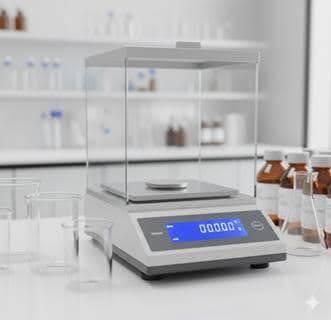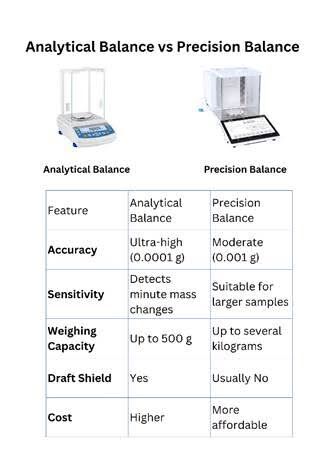Posted by Scispectrum on 13th Nov 2025
Understanding Laboratory Balances: Types, Principles, and Best Practice
Accurate measurements are the Foundation of reliable scientific research, quality control, and successful experiments. At the heart of these measurements in many labs is the laboratory balance. But with so many types, calibration methods, and specific weighing procedures, it’s easy to get confused.
In this blog post(and our accompanying video below! ?),, we’re answering the 9 most frequently asked questions about laboratory balances. Whether you’re a student, researcher, or technician, this guide will help you enhance your lab skills and ensure your weighing is always precise.
Watch the Video: Analytical Balance vs Precision Balance
1️⃣ What is a balance in a laboratory?

A laboratory balance, often simply called a “scale” in everyday language, is a highly precise instrument specifically designed to measure the mass of an object or substance. Unlike a simple kitchen scale, lab balances are engineered for exceptional accuracy and reproducibility, crucial for scientific applications where even tiny deviations can impact results.
Modern lab balances are sensitive enough to detect minute changes often as small as 0.0001 grams. Because of this, they are enclosed in draft shields to prevent interference from air currents and vibrations. This allows researchers to confidently weigh small quantities of chemicals, biological samples, or powders that form the foundation of accurate scientific data.
2️⃣ Which balance is used in a laboratory?
The type of balance used depends heavily on the required level of precision and the mass of the substance being weighed. The most common types you’ll encounter are:
- Analytical Balances – For very high precision, measuring down to 0.1 mg (0.0001 g) or even 0.01 mg (0.00001 g). They typically include an enclosed draft shield to protect against air currents.
- Precision Balances (Top-Loading Balances) – Offer good precision, typically measuring down to 0.01 g or 0.001 g. They are faster and more convenient for weighing larger samples, making them ideal for general lab use.
Analytical balances are essential in pharmaceutical, chemical, and academic laboratories, whereas precision balances are often used in quality control, food testing, and production environments.
You can explore different types of Laboratory Balances available at Scispectrum, including analytical, precision, and moisture balances, each designed for specific scientific applications.
3️⃣ What are the two types of balances?

From a modern practical perspective, the primary distinction in most labs is between:
- Analytical Balances – Characterized by their high sensitivity (four to five decimal places of a gram) and enclosed weighing chamber to prevent air disturbances.
- Precision Balances (Top-Loading Balances) – Less sensitive (two to three decimal places of a gram) and often without a full draft shield, designed for faster measurements where extreme precision isn’t required.
Historically, another key distinction was between mechanical/beam balances and electronic/digital balances, but electronic balances have now become the standard due to their speed, digital display, and ease of calibration.
4️⃣ What is a “5-point balance”?

The term “5-point balance” doesn’t refer to a specific balance model — rather, it describes a 5-point calibration procedure or linearity test.
This process checks the balance’s accuracy across its full weighing range at five points:
- Zero
- Low weight
- Mid-range weight
- High weight
- Near maximum capacity
By performing this test, laboratories ensure that the balance reads accurately at all levels, not just one. Regular 5-point tests are an important part of Good Laboratory Practice (GLP) and ISO calibration standards.
5️⃣ What are the four types of balances?
Expanding beyond the basic analytical/precision distinction, here are four common types of laboratory balances:
- Analytical Balances – High precision, enclosed in a draft shield for sensitive measurements.
- Precision Balances (Top-Loading) – Fast and efficient, used for routine weighing.
- Micro/Ultra-Micro Balances – For extremely small samples, capable of measuring down to micrograms (μg) or nanograms (ng). These require vibration isolation and a temperature-controlled environment.
- Moisture Balances – Specialized instruments combining weighing and drying, used to determine moisture content through loss-on-drying analysis.
Each type plays a vital role in maintaining accuracy and traceability across various scientific and industrial applications.
6️⃣ How to use a laboratory balance
Proper technique is vital for achieving reliable results. Here’s a step-by-step guide to using a lab balance correctly:
- Preparation: Place the balance on a stable, level, vibration-free surface. Clean the pan before use.
- Leveling: Check and adjust using the built-in spirit level and adjustable feet.
- Power On & Warm-Up: Allow the balance to stabilize (usually 30–60 minutes).
- Tare the Weighing Vessel: Place your empty container on the pan and press Tare to zero the reading.
- Add Sample: Carefully add the material using a spatula or scoop. Close the draft shield to prevent air disturbance.
- Record Reading: Wait for stability, then note the mass.
- Clean Up: Remove residues and wipe surfaces after each use.
These habits ensure long-term accuracy and reduce contamination risks — especially when weighing reactive or hygroscopic materials.
Recommended Laboratory Balances
Explore our top-rated precision and analytical balances designed for accuracy and reliability in every laboratory. Here are some of our best-selling models from Scispectrum:
Ideal for general laboratory weighing with quick response and stable performance.
The Saffron SES202S delivers fast, accurate, and stable weighing performance with a temperature-compensated load cell and anti-vibration design. It features a bright backlit LCD, simple auto-calibration, and overload protection up to 150% for reliable lab and industrial use.
Compact and efficient, perfect for labs that require milligram-level precision.
The Saffron SES200 offers high-accuracy weighing with 1 mg readability and fast 2-second stabilization. Built with a temperature-compensated load cell, anti-vibration design, and RS232 connectivity, it ensures reliable, repeatable results. Ideal for laboratories, quality control, and research applications.
Delivers excellent readability and reliability for analytical applications.
The Saffron SES224 is a high-precision analytical balance designed for laboratories requiring accuracy up to 0.1 mg. Powered by advanced Electro Magnetic Force Compensation (EMFC) technology and a fully automatic internal calibration system, it ensures fast stabilization, exceptional reliability, and repeatable results.
Built with a stainless steel 316 pan, anti-vibration features, and RS232 connectivity, the SES224 is ideal for pharmaceutical, research, and industrial labs that demand consistent accuracy.
The Shimadzu ATY224R Analytical Balance is an economical model within the AT-R Series, designed to deliver high precision and enhanced convenience for rigorous laboratory weighing procedures. This model offers a maximum weighing capacity of 220 g with a minimum display resolution of 0.1 mg.
Designed for precision and performance ideal for large-capacity measurements.
The Sartorius BSA3202S-CW is a reliable precision balance designed for accurate and efficient laboratory weighing. With a capacity of 3200 g and readability of 0.01 g, it features internal motorized calibration, fast stabilization, and RS-232 connectivity for easy data transfer. Ideal for research, quality control, and industrial labs.
The Shimadzu BL220H is a compact and affordable high-precision balance ideal for laboratories and research facilities. With a 220 g capacity and 1 mg readability, it ensures fast, stable, and accurate measurements. Equipped with unit conversion, percentage mode, and piece counting functions, it enhances daily lab efficiency. The LCD display, optional RS-232C interface, and simple windbreak cover make it both practical and user-friendly.
The Sky Series Digital Analytical Balances are designed for precision, reliability, and ease of use in laboratory applications.
- Sky-4550: Offers a capacity of 300 g with 1 mg readability, featuring automatic external calibration, TARE function, and a 90 mm pan. Ideal for high-precision weighing tasks.
- Sky-4450: Provides a larger capacity of 600 g with 0.01 g readability, along with TARE, Auto OFF, and unit conversion functions. It supports both adapter and battery operation with up to 400 hours of battery life.
Both models feature a large backlit LCD display, glass windscreen, overload protection, and a durable white plastic body, making them dependable tools for accurate and consistent measurements.
Accurate and consistent weighing is the foundation of quality laboratory work. Whether you’re conducting research, performing quality control, or handling routine analysis, choosing the right balance ensures dependable results every time.
7️⃣ What is the principle of a laboratory weighing balance?
Modern electronic laboratory balances work on the principle of electromagnetic force compensation (EFC).
When a sample is placed on the pan, the electromagnetic coil inside generates a restoring force to counterbalance the weight. The current required to create that force is directly proportional to the sample’s mass.
The balance then converts this electrical signal into a digital mass reading, displayed instantly on the screen.
This mechanism provides high-speed, high-accuracy results — ideal for precision-demanding laboratory work.
8️⃣ How to calibrate a laboratory balance
Calibration ensures your balance measures correctly and remains compliant with ISO and GLP standards.
Two types of calibration:
- Internal (Automatic) Calibration:
The balance automatically calibrates itself using built-in reference weights at regular intervals or after temperature fluctuations. - External Calibration:
A user places certified calibration weights (e.g., 100 g, 200 g) and the balance adjusts based on the deviation from the known mass.
Always record calibration data in your lab’s maintenance log. Proper calibration extends the life of your instrument and guarantees traceable accuracy for every experiment.
9️⃣ How to measure a balance test
A balance test ensures consistent performance. Common tests include:
- Repeatability Test: Check if the balance gives the same reading for the same weight across multiple trials.
- Linearity Test: Verify the accuracy across different weight points (like the 5-point test).
- Eccentricity Test: Place the same weight at different positions on the pan to ensure uniform response.
Routine testing and documentation form part of Good Weighing Practice (GWP), a global standard ensuring lab measurement quality.
Conclusion
From micrograms to kilograms, laboratory balances are the unsung heroes behind every accurate experiment. Understanding their types, principles, and calibration processes empowers every researcher to maintain the highest scientific standards.
At SciSpectrum Lab Essentials, we offer a range of Analytical, Precision, and Moisture Balances combining performance, durability, and compliance with international quality norms.
? Explore our full range today: www.scispectrum.in
? Explore all Laboratory Balances: https://scispectrum.in/balances/


